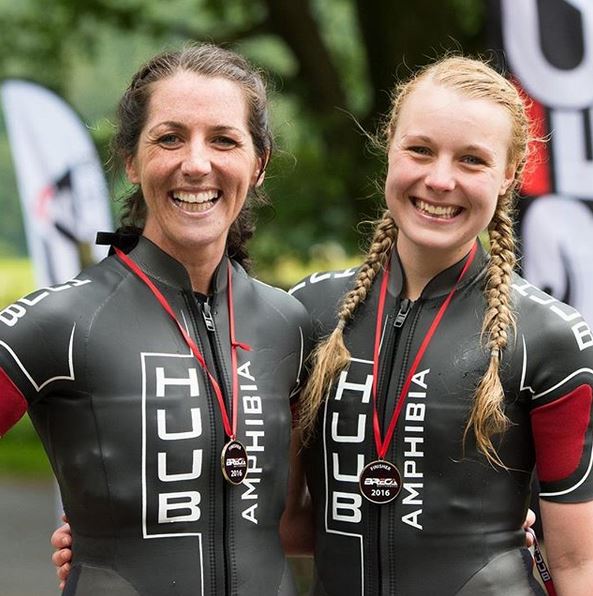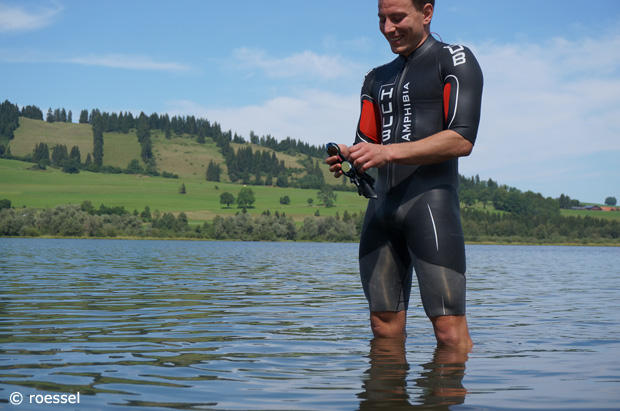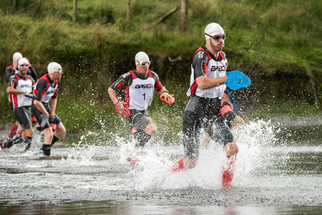Posted by HUUB Design UK on 23rd Mar 2018
Doing your first SwimRun - Things you should know
SwimRun races. What could be simpler? You swim then run, then swim, then run, then swim, then… well you get the picture.
What started as a mad idea in Scandinavia, racing across an archipelago, has now started taking off over here. The Otillo is the gold standard in Sweden, with qualifying races to be on the start line. Some races over here are either qualifiers or point earning “merit” races.
However, though it seems complex, don't be alarmed; there are plenty of less hard core athletes entering these races. So let’s help you get race ready, but from your side of the bargain, you will need to do some work.
Couple up with someone compatible

First up, you need to find a partner who fits even better than your wetsuit. Choosing a compatible partner is possibly more important than a wetsuit that fits in fact!
You race as a pair and have to stay together all the way – and by stay together we mean, usually within 10 metres of each other. So for context, think of an iron distance race, with a partner, all the way. A horrible idea for some, but once you get used to it, it’s a really great way of working as a team towards race day. And as the Brownlees proved in Cozumel this year, it’s sometimes your partner that will literally get you across the line on race day.
So in choosing a compatible race partner, you will need to be similar in pace. An unequal fitness partnership will never work. You will spend a lot of time together before the race, but also on race day making your way across challenging terrain which will not be familiar to either of you. This means that you will need to have compatible personalities too, as your acquaintance will be thoroughly put to the test.
Even if you are the best of buddies, you will also need to agree that you will hate each other at some point in the race, agree you will probably say you are never doing it again with each other, and it was a stupid idea in the first place. Then once you cross the line, you will be full of how you can do the next one better and how soon can you can get your entry forms in. Trust us, we know these things.
Choosing the right clothes for SwimRun
The second most important thing to get right is your kit. Get this wrong and your long day out will be a cold and shivery, feet blistered, hot and sweaty, scratch-legged, sore-armed, under-fuelled, miserably long slog. And you will hate each other even more. So choosing what to wear is something you need to spend time giving consideration to.
The SwimRun wetsuit

You can use a modified wetsuit but a specific SwimRun wetsuit will pay dividends. Regular wetsuits have just a back zip, but SwimRun wetsuits have a front zip. This means you can constantly regulate your temperature on the run, unzipping it, or taking out your arms and having it hanging at your waist only. On a SwimRun, the swim is usually cold and the run is hot and sweaty, so it is key to be able to slip in and out of your wetsuit, which you will wear for the entire race, easily and quickly.
For anyone who might’ve tried, attempting to put your arms back in a soaking wet wettie is nigh on impossible. Imagine how maddening this will be on race day when you have to do it upwards of 10 times too - not good for that already tested run partner relationship. So, try taking a couple of freezer bags with you, put your hands in the bags, then shoot them though the arms.
The crotch on a SwimRun wetsuit is thinner to enable you to run, and the backside is a different neoprene that is not easily ripped on rocks. The leg seams are sealed so that you can cut the legs where you want. The wetsuit comes with full length legs so you can choose, and the best cut is above the knee to ease running. Wherever you cut, make really, really sure you know where to do it. Once cut, neither you, nor we, can glue it back on again. Likewise the arms can be cut wherever you prefer, though a lot of people leave these long.
Bear in mind you will be wearing a race vest on top of your wetsuit, so the front zip is even more important.
AND… there are pockets inside, genius.
What to wear under your wetsuit
Underneath your wetsuit, you will likely find that shorts and a separate top are better than one piece. It's unlikely you will be taking your wetsuit off for a call of nature and so this is a matter of personal choice. We will leave you to decide how your own body works under duress on race day!
A pair of jammers is ideal, for both men and ladies, as they won't ride up and they won't hold water which you will really appreciate as you leave the water and embark on yet another run. The top needs to have arms which won't ruckle every time you take your arms in and out of the wetsuit or have excess material that gets caught as you unzip. Consider a vest shape.
And for your head and feet…
Shoes will be worn all the way through the event. You need to run a long way in them, be able to scramble over rocks as you get in and out of the swims, and so you leave them on.
This means you need to choose a pair that will drain quickly. As a tip, you can drill holes in the soles so they don’t hold water. A pair that is fell studded on the soles is ideal. Fell running shoes are designed for running over rough, boggy terrain and so if you have never entered the world of fell running, at least go and check out what they wear on their feet.
With socks there are two options. Short wool-based socks that are ok when wet and a pair of calf guards is one option. Whatever you think of calf guards technically, you need something to keep your legs warm and to get you relatively unscathed through brambles and bracken. The alternative is to wear long socks. These will need to be a pair that will stay up when soaked, so go for long compression socks.
Wear a swim cap under your race cap. Why wouldn't you if the water is freezing? But remember you need to be able to run in it too.
You will need goggles suitable for open water swimming and always take a spare pair between you that you can both wear. Goggles need to be robust and well-sealed. You will be pulling them on and off, so choose a pair that will not fog up and that have good quality lenses that can cope with varying light conditions.
Useful accessories to make your SwimRun go smoother

Gloves. This is where it becomes interesting. In a SwimRun you can generally take paddles to assist with extra power in the swim. So y
ou could swim with gloves to keep warm which act a bit like paddles, but think about how you are going to get them on and off when wet.
Alternatively, you could tough it out and swim with paddles glove-free. You put your fingers through some straps at the front, and put a strap at the other end for your wrist. You flip your fingers out of their strapping as you exit the swim and leave the paddle on your wrist. This leaves your hands free as you get on with your run.
Again, what to do with your hands will be a matter of personal choice that you can try out whilst training. If one of you is a stronger swimmer maybe have one of you with and one without paddles to even things up. Make sure to train with paddles if you are going to use them. They put extra pressure on your shoulders so you will need to condition them pre-race.
Pull buoys. Oh yes, don’t forget a pull buoy! Your shod feet will be heavy, so you can take a pull buoy to save your legs, but there is a clever trick. You need to thread some elastic lace through the pull buoy to hold it in place. You attach the pull buoy to your leg, but spin it inside to swim (the elastic means you won't lose it) and then move it to the outside of your leg to run. There are maximum sizes allowed in some races so check beforehand. Rough up the surface too, and this will stop it from sliding about on your wettie.
Lastly you will probably need a bumbag for some food and mandatory safety items. It needs to be only just big enough and not spin round like a sporran in the water.
Getting you around the SwimRun course
A GPS sports watch is also a good idea. The courses in a SwimRun race are long, and since you are moving over hilly terrain it will help you to keep an eye on the progress you are making. You may not always be able to judge how far you have gone whilst running in a changeable landscape and so it’ll help you with pace setting too. Don't put your watch on your wrist if your arms are going to be coming on and off in the runs. And make sure you match the units to the units the race is measured in!
On your pull buoy or paddles write down the stage distances, and in a different colour any cut offs and feed stations which will help you pace your race and cut down on any tactical thinking you might need to calculate whilst you are running.
SwimRun is unique, and it’s the kind of endurance race that will appeal to people who enjoy a bit of adventure racing, being in the mountains and don’t mind getting very, very wet. Give it a go, you might find your new calling in life!
If you are thinking of doing your first SwimRun, you might find our article on Training for SwimRun and this article on training with a partner good extra reading.

